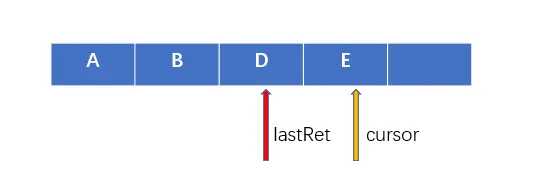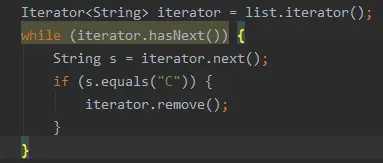标签:xpl tcap ping cat https 而不是 oid sed 位置
有序列表,允许存放重复的元素;
实现类:
ArrayList 是 java 集合框架中比较常用的数据结构了。继承自 AbstractList,实现了 List 接口。底层基于数组实现容量大小动态变化。允许 null 的存在。同时还实现了 RandomAccess、Cloneable、Serializable 接口,所以ArrayList 是支持快速访问、复制、序列化的。
ArrayList 底层是基于数组来实现容量大小动态变化的。
/** * The size of the ArrayList (the number of elements it contains). */ private int size; // 实际元素个数 transient Object[] elementData;
注意:上面的 size 是指 elementData 中实际有多少个元素,而 elementData.length 为集合容量,表示最多可以容纳多少个元素。
默认初始容量大小为 10;
/** * Default initial capacity. */ private static final int DEFAULT_CAPACITY = 10;
这个变量是定义在 AbstractList 中的。记录对 List 操作的次数。主要使用是在 Iterator,是防止在迭代的过程中集合被修改。
protected transient int modCount = 0;
下面两个变量是用在构造函数里面的
/** * Shared empty array instance used for empty instances. */ private static final Object[] EMPTY_ELEMENTDATA = {}; /** * Shared empty array instance used for default sized empty instances. We * distinguish this from EMPTY_ELEMENTDATA to know how much to inflate when * first element is added. */ private static final Object[] DEFAULTCAPACITY_EMPTY_ELEMENTDATA = {};
两个空的数组有什么区别呢? We distinguish this from EMPTY_ELEMENTDATA to know how much to inflate when first element is added. 简单来讲就是第一次添加元素时知道该 elementData 从空的构造函数还是有参构造函数被初始化的。以便确认如何扩容。
无惨构造函数
/** * Constructs an empty list with an initial capacity of ten. */ public ArrayList() { this.elementData = DEFAULTCAPACITY_EMPTY_ELEMENTDATA; }
注意:注释是说构造一个容量大小为 10 的空的 list 集合,但构造函数了只是给 elementData 赋值了一个空的数组,其实是在第一次添加元素时容量扩大至 10 的。
构造一个初始容量大小为 initialCapacity 的 ArrayList
public ArrayList(int initialCapacity) { if (initialCapacity > 0) { this.elementData = new Object[initialCapacity]; } else if (initialCapacity == 0) { this.elementData = EMPTY_ELEMENTDATA; } else { throw new IllegalArgumentException("Illegal Capacity: "+ initialCapacity); } }
由以上源码可见: 当使用无参构造函数时是把 DEFAULTCAPACITY_EMPTY_ELEMENTDATA 赋值给 elementData。 当 initialCapacity 为零时则是把 EMPTY_ELEMENTDATA 赋值给 elementData。 当 initialCapacity 大于零时初始化一个大小为 initialCapacity 的 object 数组并赋值给 elementData。
使用指定 Collection 来构造 ArrayList 的构造函数
public ArrayList(Collection<? extends E> c) { elementData = c.toArray(); if ((size = elementData.length) != 0) { // c.toArray might (incorrectly) not return Object[] (see 6260652) if (elementData.getClass() != Object[].class) elementData = Arrays.copyOf(elementData, size, Object[].class); } else { // replace with empty array. this.elementData = EMPTY_ELEMENTDATA; } }
将 Collection 转化为数组并赋值给 elementData,把 elementData 中元素的个数赋值给 size。 如果 size 不为零,则判断 elementData 的 class 类型是否为 Object[],不是的话则做一次转换。 如果 size 为零,则把 EMPTY_ELEMENTDATA 赋值给 elementData,相当于new ArrayList(0)。
public boolean add(E e) { ensureCapacityInternal(size + 1); // Increments modCount!! elementData[size++] = e; return true; } private void ensureCapacityInternal(int minCapacity) { if (elementData == DEFAULTCAPACITY_EMPTY_ELEMENTDATA) { minCapacity = Math.max(DEFAULT_CAPACITY, minCapacity); } ensureExplicitCapacity(minCapacity); } private void ensureExplicitCapacity(int minCapacity) { modCount++; // overflow-conscious code if (minCapacity - elementData.length > 0) grow(minCapacity); }
由此可见:每次添加元素到集合中时都会先确认下集合容量大小。然后将 size 自增 1。ensureCapacityInternal 函数中判断如果 elementData = DEFAULTCAPACITY_EMPTY_ELEMENTDATA 就取 DEFAULT_CAPACITY 和 minCapacity 的最大值也就是 10。这就是 EMPTY_ELEMENTDATA 与 DEFAULTCAPACITY_EMPTY_ELEMENTDATA 的区别所在。同时也验证了上面的说法:使用无惨构造函数时是在第一次添加元素时初始化容量为 10 的。ensureExplicitCapacity 中对 modCount 自增 1,记录操作次数,然后如果 minCapacity 大于 elementData 的长度,则对集合进行扩容。显然第一次添加元素时 elementData 的长度为零。那我们来看看 grow 函数。
private void grow(int minCapacity) { // overflow-conscious code int oldCapacity = elementData.length; int newCapacity = oldCapacity + (oldCapacity >> 1); if (newCapacity - minCapacity < 0) newCapacity = minCapacity; if (newCapacity - MAX_ARRAY_SIZE > 0) newCapacity = hugeCapacity(minCapacity); // minCapacity is usually close to size, so this is a win: elementData = Arrays.copyOf(elementData, newCapacity); }
很简单明了的一个函数,默认将扩容至原来容量的 1.5 倍。但是扩容之后也不一定适用,有可能太小,有可能太大。所以才会有下面两个 if 判断。如果1.5倍太小的话,则将我们所需的容量大小赋值给newCapacity,如果1.5倍太大或者我们需要的容量太大,那就直接拿 newCapacity = (minCapacity > MAX_ARRAY_SIZE) ? Integer.MAX_VALUE : MAX_ARRAY_SIZE 来扩容。然后将原数组中的数据复制到大小为 newCapacity 的新数组中,并将新数组赋值给 elementData。
public void add(int index, E element) { rangeCheckForAdd(index); ensureCapacityInternal(size + 1); // Increments modCount!! System.arraycopy(elementData, index, elementData, index + 1, size - index); elementData[index] = element; size++; } public boolean addAll(Collection<? extends E> c) { Object[] a = c.toArray(); int numNew = a.length; ensureCapacityInternal(size + numNew); // Increments modCount System.arraycopy(a, 0, elementData, size, numNew); size += numNew; return numNew != 0; } public boolean addAll(int index, Collection<? extends E> c) { rangeCheckForAdd(index); Object[] a = c.toArray(); int numNew = a.length; ensureCapacityInternal(size + numNew); // Increments modCount int numMoved = size - index; if (numMoved > 0) System.arraycopy(elementData, index, elementData, index + numNew, numMoved); System.arraycopy(a, 0, elementData, index, numNew); size += numNew; return numNew != 0; }
有以上源码可知,add(int index, E element),addAll(Collection
public E remove(int index) { rangeCheck(index); modCount++; E oldValue = elementData(index); int numMoved = size - index - 1; if (numMoved > 0) System.arraycopy(elementData, index+1, elementData, index, numMoved); elementData[--size] = null; // clear to let GC do its work return oldValue; } public boolean remove(Object o) { if (o == null) { for (int index = 0; index < size; index++) if (elementData[index] == null) { fastRemove(index); return true; } } else { for (int index = 0; index < size; index++) if (o.equals(elementData[index])) { fastRemove(index); return true; } } return false; } private void fastRemove(int index) { modCount++; int numMoved = size - index - 1; if (numMoved > 0) System.arraycopy(elementData, index+1, elementData, index,numMoved); elementData[--size] = null; // clear to let GC do its work }
当我们调用 remove(int index) 时,首先会检查 index 是否合法,然后再判断要删除的元素是否位于数组的最后一个位置。如果 index 不是最后一个,就再次调用 System.arraycopy() 方法拷贝数组。说白了就是将从 index + 1 开始向后所有的元素都向前挪一个位置。然后将数组的最后一个位置空,size - 1。如果 index 是最后一个元素那么就直接将数组的最后一个位置空,size - 1即可。 当我们调用 remove(Object o) 时,会把 o 分为是否为空来分别处理。然后对数组做遍历,找到第一个与 o 对应的下标 index,然后调用 fastRemove 方法,删除下标为 index 的元素。其实仔细观察 fastRemove(int index) 方法和 remove(int index) 方法基本全部相同。
public E get(int index) { rangeCheck(index); return elementData(index); }
由于 ArrayList 底层是基于数组实现的,所以获取元素就相当简单了,直接调用数组随机访问即可。
迭代器 iterator
有使用过集合的都知道,在用 for 遍历集合的时候是不可以对集合进行 remove操作的,因为 remove 操作会改变集合的大小。从而容易造成结果不准确甚至数组下标越界,更严重者还会抛出 ConcurrentModificationException。
foreach 遍历等同于 iterator。为了搞清楚异常原因,我们还必须过一遍源码。
public Iterator<E> iterator() { return new Itr(); }
原来是直接返回一个 Itr 对象
private class Itr implements Iterator<E> { int cursor; // index of next element to return int lastRet = -1; // index of last element returned; -1 if no such int expectedModCount = modCount; public boolean hasNext() { return cursor != size; } @SuppressWarnings("unchecked") public E next() { checkForComodification(); int i = cursor; if (i >= size) throw new NoSuchElementException(); Object[] elementData = ArrayList.this.elementData; if (i >= elementData.length) throw new ConcurrentModificationException(); cursor = i + 1; return (E) elementData[lastRet = i]; } public void remove() { if (lastRet < 0) throw new IllegalStateException(); checkForComodification(); try { ArrayList.this.remove(lastRet); cursor = lastRet; lastRet = -1; expectedModCount = modCount; } catch (IndexOutOfBoundsException ex) { throw new ConcurrentModificationException(); } } final void checkForComodification() { if (modCount != expectedModCount) throw new ConcurrentModificationException(); } }
从源码可以看出,ArrayList 定义了一个内部类 Itr 实现了 Iterator 接口。在 Itr 内部有三个成员变量。 cursor:代表下一个要访问的元素下标。 lastRet:代表上一个要访问的元素下标。 expectedModCount:代表对 ArrayList 修改次数的期望值,初始值为 modCount。
下面看看 Itr 的三个主要函数。
hasNext 实现比较简单,如果下一个元素的下标等于集合的大小 ,就证明到最后了。
next 方法也不复杂,但很关键。首先判断 expectedModCount 和 modCount 是否相等。然后对 cursor 进行判断,看是否超过集合大小和数组长度。然后将 cursor 赋值给 lastRet ,并返回下标为 lastRet 的元素。最后将 cursor 自增 1。开始时,cursor = 0,lastRet = -1;每调用一次 next 方法, cursor 和 lastRet 都会自增 1。
remove 方法首先会判断 lastRet 的值是否小于 0,然后在检查 expectedModCount 和 modCount 是否相等。接下来是关键,直接调用 ArrayList 的 remove 方法删除下标为 lastRet 的元素。然后将 lastRet 赋值给 cursor ,将 lastRet 重新赋值为 -1,并将 modCount 重新赋值给 expectedModCount。

下面我们一步一步来分析 Itr 的操作。如图一所示,开始时 cursor 指向下标为 0 的元素,lastRet 指向下标为 -1 的元素,也就是 null。每调用一次 next,cursor 和lastRet 就分别会自增 1。当 next 返回 "C" 时,cursor 和 lastRet 分别为 3 和 2 [图二]。

此时调用 remove,注意是 ArrayList 的 remove,而不是 Itr 的 remove。会将 D E 两个元素直接往前移动一位,最后一位置空,并且 modCount 会自增 1。从 remove 方法可以看出。[图三]。

此时 cursor = 3,size = 4,没有到数组末尾,所以循环继续。来到 next 方法,因为上一步的 remove 方法对 modCount 做了修改 ,致使 expectedModCount 与 modCount 不相等,这就是 ConcurrentModificationException 异常的原因所在。从例子.png中也可以看出异常出自 ArrayList 中的内部类 Itr 中的 checkForComodification 方法。
异常的解决:

直接调用 iterator.remove() 即可。因为在该方法中增加了 expectedModCount = modCount 操作。但是这个 remove 方法也有弊端。
总结: ArrayList 底层基于数组实现容量大小动态可变。 扩容机制为首先扩容为原始容量的 1.5 倍。如果1.5倍太小的话,则将我们所需的容量大小赋值给 newCapacity,如果1.5倍太大或者我们需要的容量太大,那就直接拿 newCapacity = (minCapacity > MAX_ARRAY_SIZE) ? Integer.MAX_VALUE : MAX_ARRAY_SIZE 来扩容。 扩容之后是通过数组的拷贝来确保元素的准确性的,所以尽可能减少扩容操作。 ArrayList 的最大存储能力:Integer.MAX_VALUE。 size 为集合中存储的元素的个数。elementData.length 为数组长度,表示最多可以存储多少个元素。 如果需要边遍历边 remove ,必须使用 iterator。且 remove 之前必须先 next,next 之后只能用一次 remove。
标签:xpl tcap ping cat https 而不是 oid sed 位置
原文地址:https://www.cnblogs.com/yuexiaoyun/p/12046037.html